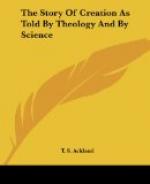We turn now to the Mosaic Record to see what light it throws upon and receives from this investigation. The first thing to be noticed is that the word used by Moses for the sun and moon is not the same as that employed to denote light. It properly signifies a light-holder, such as a candlestick, and harmonizes with the view that the sun in his original state was not luminous, but was made a luminary by the condensation of light previously existent under other conditions. In the next place, though the apparent dimensions of the sun and moon are the same, Moses correctly describes the one as “the great light,” the other as “the little light,” thus indicating a knowledge to which the astronomers of his day had probably not attained.
The relation between the accounts of the first and fourth day’s work becomes clear if we assume that the sun was not made a luminary till the fourth day. The division of night and day depends upon two things, the rotation of the earth upon its axis, and the concentration of light in the sun. Hence when the rotation of the earth commenced that division was potentially provided for, but the provision would not take effect until the second condition was fulfilled by the concentration of light in the sun. The indications given by the coal measures point, as we have seen, to the same conclusion.
The only remaining question is “What was going on in the earth at the same time?” Our materials for answering this question are but scanty. So great an alteration in the sources of light and heat must have involved great physical changes on the earth’s surface, and there is reason to believe that great mechanical forces were at work producing vast changes in the relations of land and water. “It has long been the opinion of the most eminent geologists that the coalfields of Lancashire and Yorkshire were once united, the upper coal measures and the overlying Millstone Grit and Toredale Bocks having been subsequently removed by denudation; but what is remarkable is the ancient date now assigned to this denudation, for it seems that a thickness of no less than 10,000 feet of the coal measures had been carried away before the deposition of even the lower Permian Rocks, which were thrown down upon the already disturbed truncated edges of the coal strata.” [Footnote: Lyell, Geology for Students, p. 377.] And this is but a single instance.




